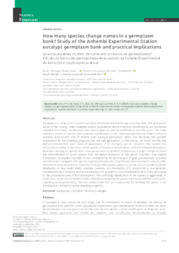How many species change names in a germplasm bank? Study of the Anhembi Experimental Station eucalypt germplasm bank and practical implications.
How many species change names in a germplasm bank? Study of the Anhembi Experimental Station eucalypt germplasm bank and practical implications.
Autoria: SILVA, P. H. M.; ASSIS, T. F. de; BUSH, D.; KLEINIG, D.; REIS, C. A. F.
Resumo: Eucalypts are a long-cycle crop that have been introduced in Brazil during several decades. The germplasm banks of the country make available several populations whose botanical classifications are somewhat outdated since these classifications have been subject to several modifications over the years. This study outlines a review of species with outdated classifications in the Anhembi Experimental Station of Forest Sciences (ESALQ/USP), one of Brazil?s main eucalypt germplasm banks and discusses the possible implications for the breeding programs that use said germplasm. In this survey, we found records that indicate introductions were made of populations of 20 eucalypts species. However, this number has increased according to the most recent update of botanical classifications, and the Anhembi Germplasm Bank has currently 22 species after a few species were reclassified. Furthermore, a major change has been the reclassification of some species from the genus Eucalyptus to the genus Corymbia. One original introduction, Eucalyptus maculata, is now considered to be (according to original provenances), Corymbia maculata and C. variegata. One species originally introduced as E. pellita has been renamed E. scias; E. pellita still exists in north Queensland, Australia and Papua New Guinea, while E. scias has a much smaller southerly distribution in New South Wales, Australia. Similarly, an introduction of E. phaeotricha is now generally considered to be E. tindaliae, and an introduction of E. resinifera is now considered to be E. macta (according to the provenance area of the introduction). The confusing classification of the species is aggravated, in some cases, by the lack of detailed studies that allow comparing the species introduced with the same name, regarding wood productivity, tolerance and/or traits that are fundamental for defining the species to be introduced or worked on by the breeding programs.
Ano de publicação: 2023
Tipo de publicação: Artigo de periódico
Unidade: Embrapa Florestas
Palavras-chave: Banco de Germoplasma, Corymbia, Eucalyptus, Germplasm bank, Taxonomia, Taxonomy
Observações
1 - Por padrão são exibidas publicações dos últimos 20 anos. Para encontrar publicações mais antigas, configure o filtro ano de publicação, colocando o ano a partir do qual você deseja encontrar publicações. O filtro está na coluna da esquerda na busca acima.
2 - Para ler algumas publicações da Embrapa (apenas as que estão em formato ePub), é necessário ter, no celular ou computador, um desses softwares gratuitos. Sistemas Android: Google Play Livros; IOS: iBooks; Windows e Linux: software Calibre.
Acesse outras publicações
Acesse a Base de Dados da Pesquisa Agropecuária (BDPA) para consultar o acervo completo das bibliotecas da Embrapa.

